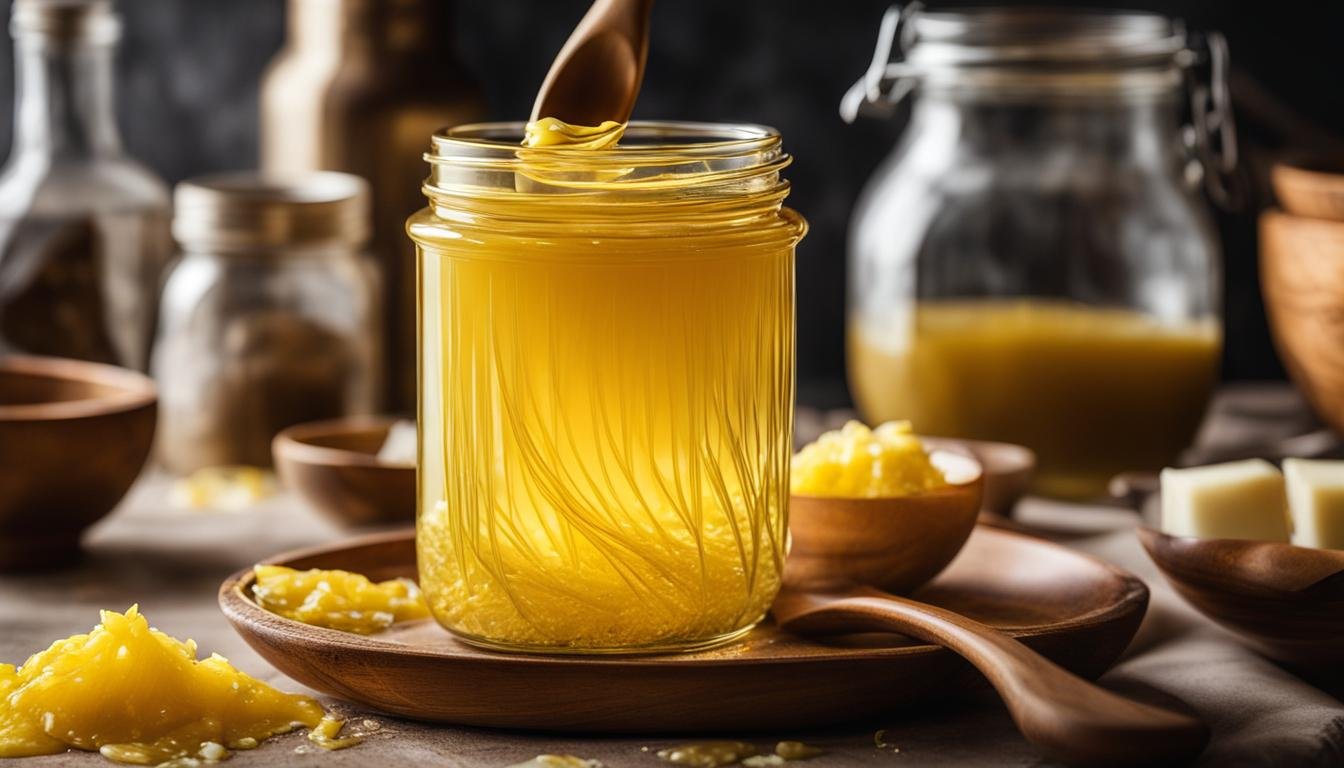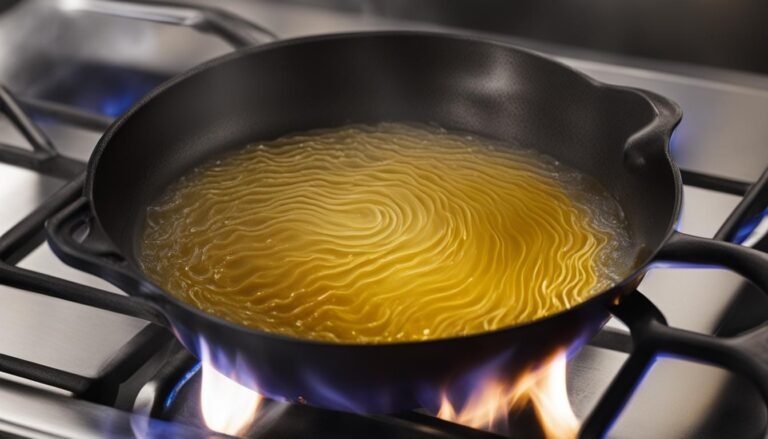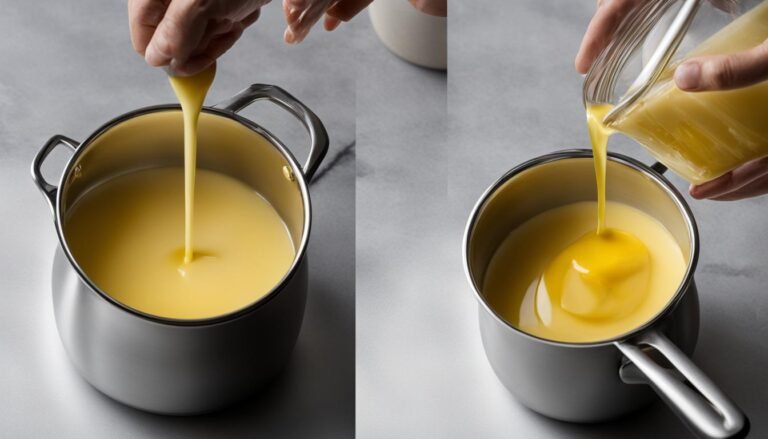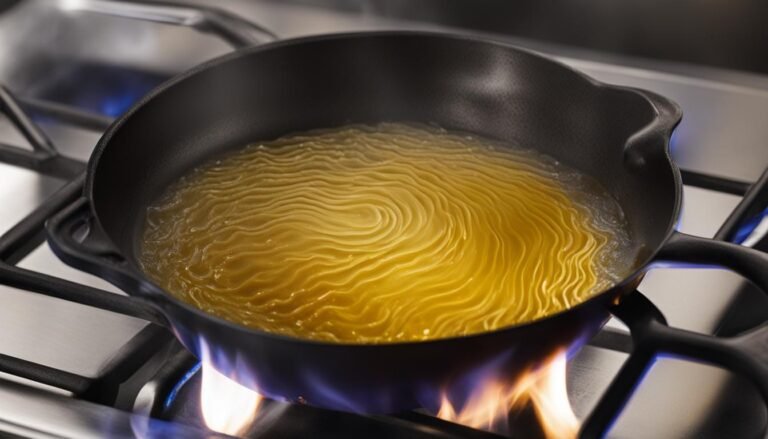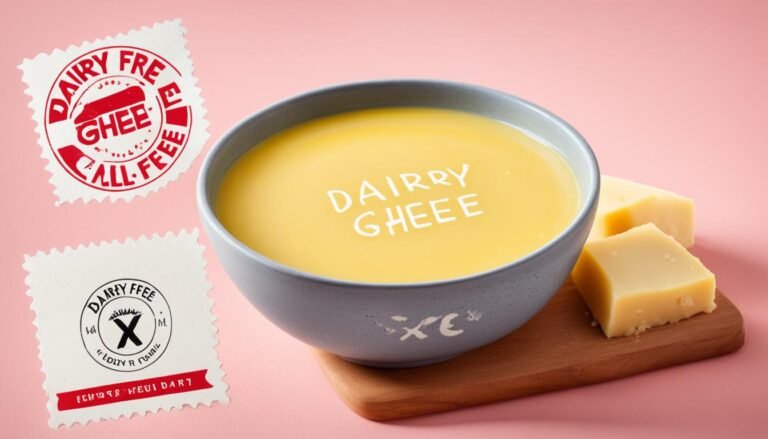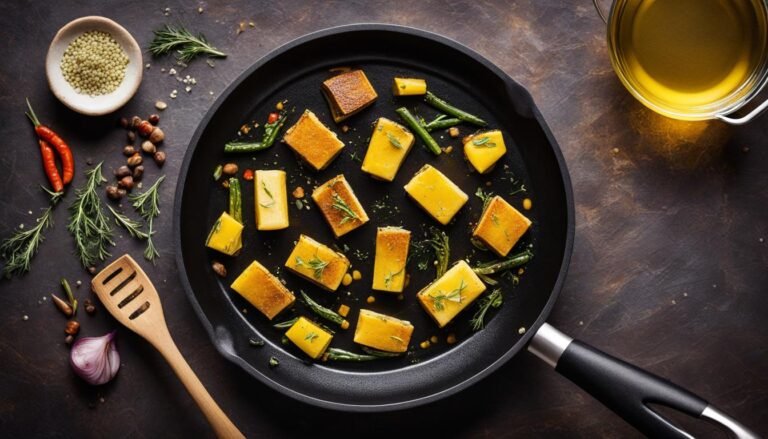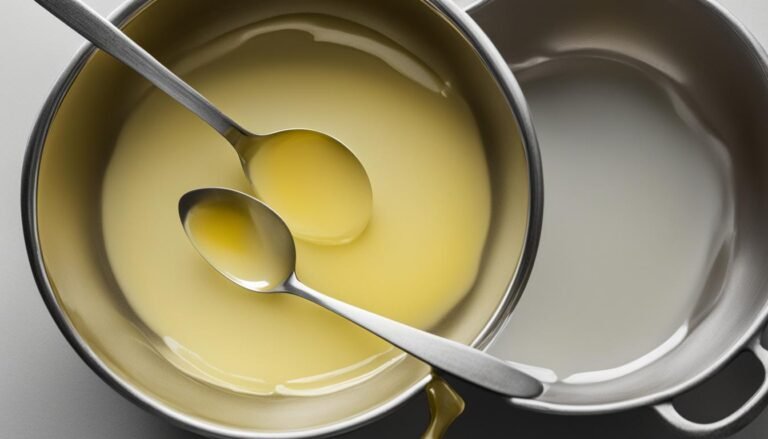Discover What Is Ghee: Clarified Butter’s Rich Cousin
Are you familiar with ghee? If not, get ready to learn about this delicious and versatile ingredient that has been a staple in South Asian cooking for centuries. Ghee, also known as clarified butter, is a rich and flavorful fat that offers a unique twist on regular butter. In this article, we’ll explore what ghee is made of, its uses in cooking, and how it differs from traditional butter. Let’s dive in!
Key Takeaways:
- Ghee is a South Asian clarified butter with a slightly nutty and caramel-like flavor.
- It is made by separating butterfat from milk solids and water through a simmering process.
- Ghee has a higher smoking point than butter and can be stored at room temperature.
- It is commonly used in South Asian cooking and can be a substitute for butter or vegetable oil.
- Ghee is suitable for individuals with lactose intolerance due to its low lactose content.
How Is Ghee Made and What Are Its Nutritional Values?
Ghee, a delicious and versatile ingredient, is made through a careful process that begins with melting fresh butter. The butter is then simmered for an extended period, allowing the moisture in the milk solids to evaporate. This slow and deliberate process creates a clarified liquid fat known as ghee.
Ghee is a powerhouse of nutrition, but it is essential to understand its nutritional values to make informed dietary choices. As a source of energy, ghee is rich in calories, containing approximately 130 calories per tablespoon. It is also high in fat, with 15 grams per tablespoon, which adds richness and flavor to dishes.
While ghee does not contain any protein or carbohydrates, it is a good source of certain nutrients. Ghee provides a healthy dose of Vitamin E, an antioxidant that supports skin health and boosts the immune system. Additionally, ghee contains Omega-3 fatty acids, which are beneficial for heart health.
However, it is crucial to consume ghee in moderation, considering its high fat content. Excessive consumption of ghee can lead to weight gain and an increased risk of obesity. Therefore, it is advisable to incorporate ghee into a well-balanced diet, ensuring portion control.
Health Benefits of Ghee
Ghee, the rich and flavorful clarified butter, offers numerous health benefits that make it an excellent addition to your diet. With its unique combination of nutrients and properties, ghee has been recognized for its positive effects on various aspects of health and well-being.
One of the key health benefits of ghee is its anti-inflammatory effects. Ghee contains butyrate, a fatty acid that has been shown to have strong anti-inflammatory properties. This means that consuming ghee can help reduce inflammation in the body, which is often associated with various chronic diseases.
Ghee also has the potential to combat obesity and support weight management. It contains conjugated linoleic acid (CLA), a compound known for its ability to reduce body fat and promote weight loss. By incorporating ghee into your diet, you may experience improved weight management and a healthier body composition.
Ghee can play a role in supporting heart health. It is rich in monounsaturated Omega-3 fatty acids, which have been linked to a reduced risk of heart disease. These healthy fats can help lower cholesterol levels and improve heart function, making ghee a heart-friendly addition to your meals.
For those with lactose intolerance or dairy allergies, ghee serves as a beneficial alternative to traditional dairy products. Ghee has low lactose and casein content, which are the components of dairy that often cause digestive issues. By substituting ghee for other dairy products, individuals with lactose intolerance can enjoy the taste and benefits of dairy without experiencing discomfort or allergic reactions.
“Ghee has several potential health benefits, including its anti-inflammatory effects, ability to combat obesity, support heart health, and serve as a suitable alternative for lactose products.”
Overall, ghee’s health benefits make it an excellent choice for improving your overall well-being and enjoying a delicious ingredient in your meals. Incorporate ghee into your cooking and experience its positive impact on your health and lifestyle.
Cooking and Using Ghee
Ghee is a versatile ingredient that adds a rich and nutty flavor to dishes. It is widely used in South Asian cooking, where it serves as the base for tadka (a spice mix) and is brushed on flatbreads such as naan and roti. Its unique flavor enhances the taste of rice and lentil dishes, and it is also commonly used in desserts.
Many cuisines around the world also incorporate ghee into their recipes. It can be used as a substitute for butter or vegetable oil, providing a distinct, savory flavor. When cooking with ghee, it is important to note its high smoking point, which makes it suitable for high-temperature cooking methods.
Ghee is a versatile ingredient that can be used in various ways:
- Cooking eggs: Use ghee to fry or scramble eggs for a rich and flavorful breakfast.
- Making pancakes: Replace butter or oil with ghee in your pancake batter for an added depth of flavor.
- Sautéing vegetables: Ghee adds a delicious taste when sautéing vegetables, enhancing their natural flavors.
- Deep-frying: Due to its high smoking point, ghee is an excellent choice for deep-frying, providing a golden and crispy texture.
- Baking: Replace butter or oil with ghee in baking recipes to bring out a unique and rich taste.
For those looking for vegan alternatives to ghee, there are several options. Coconut oil, extra-virgin olive oil, and sunflower oil can be used as substitutes in cooking and baking. While they may not have the exact same flavor profile as ghee, they provide similar cooking properties and can still enhance the taste of your dishes.
Ghee adds a delicious nutty flavor and a creamy texture to your recipes. Its versatility in cooking methods makes it a staple ingredient in many kitchens worldwide. Whether you’re sautéing veggies, deep-frying crispy treats, or baking indulgent desserts, ghee is a reliable ingredient that will take your dishes to the next level.
Try incorporating ghee into your favorite recipes and explore its unique and flavorful profile. It’s time to elevate your cooking with the rich taste of ghee!
Where to Buy Ghee
Looking to buy ghee? You’re in luck! Ghee is now widely available and can be purchased from various retailers. Whether you prefer to shop in person or online, there are plenty of options to choose from.
When it comes to buying ghee, you have a few different choices. One option is to visit wholesale retailers or large grocery stores, where you can find a variety of ghee brands. These stores often have a dedicated section for oils and cooking fats, so keep an eye out for ghee while you browse.
If you prefer the convenience of online shopping, you can easily find ghee on popular e-commerce platforms. With just a few clicks, you can browse through different ghee brands, compare prices, and read customer reviews to find the one that suits your needs.
It’s worth noting that ghee is no longer considered a specialty ingredient confined to South Asian or Middle Eastern grocery stores. While you can still find ghee in those types of stores, it is much more widely available now, thanks to its growing popularity.
So, which brands should you consider? Here are some commonly available ghee brands:
- Swad
- Pure Indian Foods
- 4th and Heart
- Tin Star Foods
- Organic Valley
These brands offer a range of ghee options, so you can find the one that fits your preferences.
When it comes to the price of ghee, it can vary depending on the brand and the size of the container. Larger containers may be more cost-effective if you use ghee frequently, while smaller ones are great for occasional use or for trying out different brands.
Now that you know where to buy ghee and have some trusted brands to choose from, you can easily add this delicious and versatile ingredient to your pantry.
How to Make Ghee at Home
Making ghee at home is a simple and rewarding process that allows you to enjoy the rich flavors of homemade ghee. Follow these easy steps to create your own batch of golden, fragrant ghee.
Ingredients:
- Unsalted butter
Equipment:
- Heavy-bottomed saucepan
- Cheesecloth or a fine-mesh strainer
- Heat-resistant jar for storing
Instructions:
- Place the unsalted butter in a heavy-bottomed saucepan.
- Heat the saucepan over medium heat until the butter melts and starts to simmer.
- Continue to simmer the butter, stirring occasionally, until you start to see the milk solids separate and sink to the bottom of the pan.
- As the simmering continues, the water in the butter will begin to evaporate, and the butter will become clearer.
- Monitor the process closely to prevent the butter from burning.
- Once the simmering has stopped and the milk solids have turned golden brown, remove the saucepan from heat.
- Allow the ghee to cool slightly before straining it through a cheesecloth or fine-mesh strainer into a heat-resistant jar.
- Discard the milk solids left in the strainer.
- Your homemade ghee is now ready to use or store.
Storing Homemade Ghee:
Transfer the strained ghee into a clean, airtight jar. Store it in the refrigerator to maintain its quality and freshness. Homemade ghee can last up to 3 months when properly stored.
Enjoy the Fruits of Your Labor
Now that you know how to make homemade ghee, you can enjoy the rich flavors and numerous culinary possibilities it offers. Experimenting with your own ghee recipe will allow you to tailor the taste and aroma to your preference. It’s time to elevate your dishes with the wonderful flavors of homemade ghee!
Considerations and Precautions When Consuming Ghee
While ghee offers various health benefits, it is essential to consume it in moderation due to its high saturated fat content. Individuals with heart disease or those at risk should exercise caution when incorporating ghee into their diet. It is recommended to consult with a healthcare professional before making dietary choices regarding ghee or any other food.
Ghee is a flavorful ingredient that adds richness to dishes; however, excessive consumption can lead to weight gain and increase the risk of obesity. It is important to be mindful of portion sizes and balance ghee consumption with a healthy and well-rounded diet.
“Moderation is key when it comes to consuming ghee. While it can enhance the taste of meals, too much of it can have detrimental effects on your health. It’s always best to enjoy ghee in moderation and seek guidance from a healthcare professional to ensure optimal well-being.”
Although ghee has unique properties that may benefit certain individuals, everyone’s dietary needs and requirements differ. Personal health factors, such as cholesterol levels, weight goals, and overall lifestyle, should be taken into consideration when deciding on ghee consumption. A balanced approach to nutrition is crucial, and individuals should be mindful of their overall fat intake, including ghee, in their daily diet.
To better understand the impact of ghee on your specific health condition, it is advisable to consult with a doctor or registered dietitian. They can provide personalized guidance and help you make informed decisions about ghee consumption.
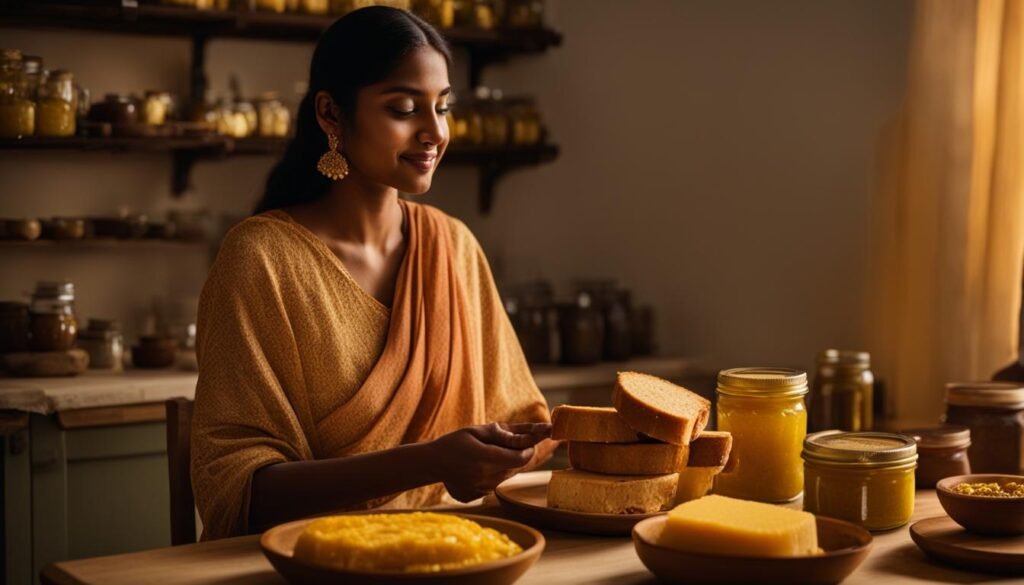
Conclusion
Ghee is a versatile and nutritious ingredient that has been enjoyed for centuries. Derived from South Asian cuisine, ghee is a clarified butter with a delightful nutty flavor and a higher smoking point than regular butter. Its unique characteristics make it a popular choice for cooking, baking, and sautéing, adding a rich and indulgent taste to various dishes.
Aside from its exceptional taste, ghee also offers potential health benefits. It contains butyrate, a fatty acid known for its anti-inflammatory properties, making it a valuable addition to a balanced diet. Additionally, ghee is rich in monounsaturated Omega-3s, which can support heart health by helping to lower unhealthy cholesterol levels.
While ghee provides numerous advantages, it is important to consume it in moderation. Due to its high calorie and fat content, excessive intake may lead to weight gain and other associated health risks. However, when used mindfully, ghee can be a valuable addition to your kitchen, enhancing the flavor and nutritional profile of your favorite recipes.
Whether you choose to use ghee for its rich taste or its potential health benefits, incorporating this versatile ingredient into your cooking routine can elevate your culinary experiences. So why not explore the vast array of ghee recipes available and unleash your creativity in the kitchen with this flavorful and wholesome ingredient?
FAQ
What is ghee?
Ghee is a South Asian clarified butter that originated in the Indus Valley around 8,000 years ago.
What is ghee made of?
Ghee is made by separating butterfat from the milk solids and water in butter through a simmering process.
What is ghee used for?
Ghee is commonly used in South Asian cooking and can be used as a substitute for butter or vegetable oil in various recipes.
What is the difference between ghee and butter?
Ghee has a slightly nutty and caramel-like flavor, with a lighter and grainier texture than butter. It also has a higher smoking point and can be stored at room temperature, making it suitable for those with lactose intolerance.
How is ghee made?
Ghee is made by melting fresh butter and simmering it for a long time to allow the moisture present in the milk solids to evaporate. It is then strained to remove the milk solids, resulting in a clarified liquid fat.
What are the nutritional values of ghee?
Ghee is high in calories (130 calories per tablespoon) and fat (15 grams per tablespoon), with no protein or carbohydrates. It is a good source of Vitamin E and contains Omega-3s.
What are the health benefits of ghee?
Ghee contains butyrate, a fatty acid with anti-inflammatory properties, which can help soothe inflammation within the body. The conjugated linoleic acid (CLA) found in ghee may also help combat obesity and reduce body fat. Ghee’s high concentrations of monounsaturated Omega-3s can support heart health. It is also a suitable alternative for those with lactose intolerance or dairy allergies.
How can ghee be used in cooking?
Ghee is widely used in South Asian cooking as a base for tadka (spice mix), brushed on flatbreads, stirred into rice and lentil dishes, and used in desserts. It can be used as a substitute for butter or vegetable oil in various cuisines and can be used for cooking eggs, pancakes, vegetables, sautéing, deep-frying, and baking.
Where can I buy ghee?
Ghee can be purchased from wholesale retailers, large grocery stores, and online. Some commonly available brands include Swad, Pure Indian Foods, 4th and Heart, Tin Star Foods, and Organic Valley.
How can I make ghee at home?
Making ghee at home involves melting unsalted butter in a heavy-bottomed saucepan over medium heat until it simmers and the water in the milk solids has evaporated. The butter is then cooled and strained through a cheesecloth into a jar.
Are there any precautions when consuming ghee?
While ghee has health benefits, it should be consumed in moderation as it is high in saturated fat. People with heart disease or those at risk should exercise caution when adding ghee to their diet. Additionally, consuming excessive amounts of ghee can lead to weight gain and increase the risk of obesity.

